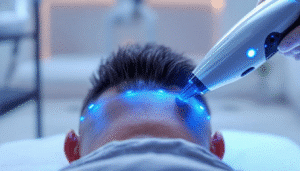Concerned about a thinning hairline? Find out the causes, symptoms, and treatments for a thin hairline female. We’ll guide you through understanding why it happens and what you can do to address it.
Key Takeaways
Thinning hairlines in women, known as alopecia areata, can result from genetic factors, hormonal fluctuations, nutritional deficiencies, and hair care habits.
Recognizing early symptoms such as thinning at the temples and increased scalp visibility is crucial for timely diagnosis and intervention.
Treatment options for thinning hairlines include medications like Minoxidil, nutritional supplements, advanced therapies like PRP, and lifestyle changes to promote hair health.
Understanding Thin Hairlines in Women

Thinning hair is referred to as alopecia areata. It can occur on the scalp or body and may be temporary or permanent. Female Pattern Hair Loss (FPHL) is a common condition characterized by gradual thinning of hair on the top and crown of the scalp. Unlike male pattern baldness, FPHL does not lead to total baldness but results in a noticeable reduction in hair density.
A receding hairline in women refers to hair on the front part of the scalp thinning and moving towards the back. This can change the shape of the face, making a small forehead appear larger and potentially altering one’s overall appearance. The emotional impact of a thinning hairline can lead to distress and decreased self-esteem for many women, especially those experiencing a female receding hairline.
Typical receding hairlines in women often result in a larger forehead or an M-shaped hairline, unlike male pattern baldness which tends to affect the crown and temples more severely. Many women find this change distressing, as it can significantly impact their self-esteem and confidence. As women age, hair loss becomes more common, further contributing to emotional challenges related to self-image.
Common Causes of Thin Hairlines in Women

Genetic factors often play a significant role in female pattern baldness, with a tendency for pattern baldness being inherited from either parent. This genetic predisposition leads to overall thinning across the scalp, unlike male pattern baldness which typically results in total baldness. Female androgenetic alopecia, also known as hereditary hair loss, is a primary cause of hair thinning in women.
Hormonal fluctuations are another major contributor to hair loss in women. During and after pregnancy, many women experience temporary hair loss due to hormonal changes. Similarly, menopause and conditions like PCOS can lead to significant hair thinning. These hormonal changes can cause the hair follicles to shrink, leading to finer hair and a thinning hairline.
Nutritional deficiencies, particularly in vitamins and minerals, can weaken hair and lead to thinner hairlines. Significant stress can also temporarily push hair follicles into a resting phase, resulting in hair loss. Daily habits such as tight hairstyles and poor hair care can contribute to hairline recession in women. Traction alopecia occurs from consistent pulling on the hair due to tight hairstyles like ponytails.
Recognizing Symptoms of a Thinning Hairline
Before:
Recognizing early signs of hairline recession, like thinning at the temples, is crucial for timely intervention. Women may notice a widening of their part or more scalp visibility, indicating a thinning hairline. Visible decreases in density and more skin showing on the frontal scalp are signs of a receding hairline.
After:
Recognizing early signs of hairline recession is crucial for timely intervention. Here are some signs to look out for:
Thinning at the temples
Widening of the part
Increased scalp visibility
Visible decreases in density
More skin showing on the frontal scalp
Feeling hair breakage can be an indication of a weakening hairline. Noticing more hair on pillows or in brushes can also suggest thinning hair. These signs can be subtle but are important to notice early to prevent further hair loss.
Looking in the mirror or a photograph may lead someone to notice a receding hairline. Hairline recession can be a rare symptom of female hair loss, but it is important to recognize it early for effective treatment.
Diagnosing the Underlying Cause
Consulting a healthcare professional is essential for an accurate diagnosis regarding thinning hairlines. Initial diagnostic steps include a detailed consultation, medical history review, and an examination of hair loss patterns. Factors influencing the diagnosis include family history of hair loss, existing medical conditions, and lifestyle factors.
Further examinations may involve a scalp examination under a microscope, analyzing scalp tissue through a biopsy, or blood tests for deficiencies. These diagnostic steps help identify the underlying cause of hair loss, allowing for a more targeted and effective treatment plan.
Treatment Options for Thinning Hairlines

Medications are a primary treatment approach for hair loss in women. Common treatment options for receding hairlines in women include various medications that target hormonal imbalances.
Stopping the use of Minoxidil, for example, can result in hair falling back out.
Topical Treatments
Minoxidil is the only hair loss treatment fully approved for women. It is used for promoting hair growth and is a common choice for those experiencing a thinning hairline. Spectral.CSF. Lotion is another topical treatment noted for its positive effects on hair growth.
Topical treatments are often applied directly to the scalp and can be effective in stimulating hair growth across the whole scalp. However, it’s important to continue using these treatments consistently, as stopping them can result in hair falling back out.
Oral Medications
Anti-androgens can be beneficial for women dealing with hair loss related to hormonal issues. Hormonal imbalances can significantly contribute to hair loss in women, making it an important factor to consider in treatment. Birth control pills are another option for managing hormonal imbalances that cause hair loss.
Oral medications are often prescribed based on a detailed medical history and are considered an important part of medical treatments for hair loss. These medications can help regulate hormone levels and stop hair loss effectively.
Nutritional Supplements
Deficiencies in iron, vitamin B12, and biotin can cause hair loss. Biotin plays a crucial role in hair growth, making it a popular choice for those looking to promote hair growth. Vitamin C is also essential for collagen production, which is vital for hair health.
Omega-3 fatty acids found in fish oil are beneficial for promoting hair growth. Including foods rich in vitamins A, C, and E, as well as iron and zinc, is crucial for promoting hair growth and addressing nutritional deficiencies.
Advanced Treatments for Severe Cases
Advanced treatments for severe hair thinning often involve procedures that stimulate hair growth at a deeper level, such as PRP therapy and hair transplants.
Platelet Rich Plasma (PRP) Therapy
PRP therapy is increasingly recognized for its role in promoting hair regrowth in women with thinning hair. The therapy involves extracting platelets from a blood draw and injecting them into the scalp to stimulate blood flow and promote hair follicle health and regeneration.
Research indicates that PRP can significantly improve hair density and thickness in women experiencing hair loss. Patients can typically expect to see results from PRP therapy after six months.
Hair Transplants
Hair transplantation involves removing hair follicles from a donor site to a thinning area. The FUE hair transplant method is minimally invasive and considered the best type for women. FUE allows for the extraction of individual hair follicles for transplantation, offering a more natural appearance.
Discussing your medical history and hair loss progression with a hair transplant specialist is crucial for determining the best approach. Hair transplants are typically performed using the FUE method, which allows for the extraction of individual hair follicles for transplantation.
Lifestyle Changes to Prevent Further Thinning
Lifestyle changes can help prevent further hair thinning, such as stress management, a healthy diet, and proper hair care.
Stress Management
Stress can lead to hair loss, making stress management an essential part of hair loss treatment options. Exercise, meditation, and a healthy diet are effective ways to manage stress and prevent hair loss. Identifying stress triggers can help in developing effective coping strategies to mitigate hair loss.
Incorporating stress management techniques into your daily routine can reduce the impact of stress on your hair and overall health.
Healthy Diet
A nutrient-rich diet, including iron and protein, is crucial for maintaining healthy hair. Essential nutrients such as vitamins, minerals, and proteins play a vital role in supporting hair growth. Regular consumption of a balanced diet can significantly improve hair health and reduce thinning.
Incorporating foods high in vitamins and minerals can help prevent nutritional deficiencies and promote hair growth.
Proper Hair Care
Using a gentle shampoo can help preserve moisture and prevent further hair damage. Sulfate-free shampoos are particularly beneficial for maintaining hair moisture and reducing hair loss.
Limiting the use of heat styling tools can prevent damage and breakage, which is essential for maintaining hair health. Avoiding heat styling tools can reduce damage to hair and improve its overall health.
Hairstyles to Conceal a Thinning Hairline

Choosing the right hairstyle can effectively conceal a thinning hairline and boost confidence among women. A brushed forward pixie cut can effectively disguise a receding hairline and is favored by many women with thinning hair. A side-swept bob can conceal uneven thinning by directing hair across the scalp, and using hair fibers can enhance the appearance of volume.
A full fringe is one of the most effective hairstyles to mask a receding hairline, providing significant coverage. Bold, curly hairstyles add volume, which can help conceal thinning areas, especially when kept relatively short to avoid weight pulling down the curls.
Using scarves or hair accessories can help hide thinning areas while showcasing the lengths of the hair, offering versatility in styling. Choosing flattering hairstyles not only instantaneously improves appearance but also helps in boosting confidence for women struggling with thinning hairlines.
Mental Health Impact and Support
Experiencing hair loss can lead to feelings of isolation and depression, significantly diminishing quality of life. Women often experience emotional distress related to changes in their hairline, impacting their self-esteem.
Support groups and counseling are recommended as effective resources for women dealing with the emotional impact of hair loss. Practicing mindfulness techniques can significantly reduce stress levels, contributing to better hair retention.
Summary
Understanding the causes, symptoms, and treatment options for a thinning hairline can empower you to take control of your hair health. From recognizing early signs to exploring advanced treatment options, this guide provides a comprehensive approach to managing hair loss. Remember, you are not alone, and effective treatments and support are available.
Frequently Asked Questions
Can you fix a female receding hairline?
A hair transplant can effectively address a female receding hairline, especially for those with androgenetic alopecia. If supplements or lifestyle changes prove inadequate, this surgical option may be the most viable solution.
What is the most common cause of thinning hairlines in women?** **?
The most common cause of thinning hairlines in women is Female Pattern Hair Loss (FPHL), typically related to genetic predisposition. This condition leads to decreased hair density rather than complete baldness.
Can stress cause hair thinning?** **?
Yes, stress can lead to hair thinning by causing hair follicles to enter a resting phase, resulting in temporary hair loss. It’s important to manage stress through practices like exercise, meditation, and maintaining a healthy diet.
Are there any non-medical treatments for thinning hairlines?** **?
Non-medical treatments for thinning hairlines include lifestyle changes like stress management, a balanced diet, and appropriate hair care. Additionally, choosing hairstyles that conceal thinning areas can enhance your confidence.
How effective is PRP therapy for hair regrowth?** **?
PRP therapy is effective for hair regrowth, particularly in women with thinning hair, as it stimulates hair follicle health through concentrated platelet injections. Most users begin to notice results after approximately six months.

